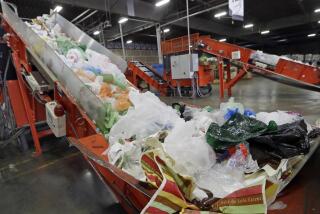Environmentalists Fail in Effort to Give Plastic Grocery Bags the Sack
- Share via
Plastic grocery bags, those lightweight, crinkly carriers that have turned up at Southern California supermarkets in the last couple of years, have apparently weathered a campaign by environmentalists and are here to stay.
Californians Against Waste, an environmental lobbying group, launched a campaign last November to get its 35,000 members to write letters to local supermarkets stating their preference for paper bags.
“It’s not so much that we find (plastic bags) objectionable as we find paper superior product because it is biodegradable and recycleable,” said Amy Lethbridge, citizen lobby coordinator for Californians Against Waste.
The plastic “T-shirt bags,” so called because of their color and shape, may be a lot more permanent. Lethbridge said there are 25 billion grocery bags used in the United States every year, about 3 billion in California alone. “If those were all plastic, it would have tremendous impact on our landfill,” she said.
She said that although it’s difficult to gauge how many letters have actually been sent to supermarkets, “judging from the letters we have gotten, the campaign has been successful. Quite a few people from all over the state are writing letters to our stores.”
However, big chains such as Ralphs, Vons and Safeway report that letters from consumers complaining about the bags, far from pouring in, have dwindled since the bags were introduced.
“Now we just get a handful of complaints,” said Jan Charles Gray, a Ralphs vice president. “People who want plastic far (outnumber) those who don’t. . . . We are not thinking of abandoning one for the other. Providing both now provides us a balance.”
Plastic also provides grocers with lower costs. According to one estimate, paper bags may be 15% to 20% more expensive than plastic, and the cost of the kraft paper from which the bags are made has risen 30% in the last year.
Sonoco Products Co., a plastic bag maker based in Hartsville, S.C., estimates that 50% of all Southern California chains now offer plastic bags, compared to 36% statewide. But shoppers are usually offered a choice between the two.
Urban and elderly shoppers who walk to stores or have to rely on public transportation prefer plastic bags, which have sturdy handles that make them easy to carry. Store operators have found that the easy-to-handle bags have also help cut down on the loss of shopping baskets, which is a hefty expense for supermarkets.
The waterproof plastic also makes a free, sturdy trash bag after the groceries have arrived home.
Auto-bound, suburban shoppers, however, tend to shun plastic because they say the bags tend to fall over in car trunks so groceries spill out. And because of their smaller capacity, plastic bags’ price advantage often disappears because it may take more of them to pack an order than conventional bags.
But Sonoco says it is the cost savings that will “propel the conversion of plastic in the rest of the country.” The company estimates that by 1988 the plastic grocery sack will account for 65% to 70% of the market nationwide.
“The West Coast market is more equal--there are many more chains of the same size and with the same resources competing for the same customers,” said H. Gordon Dancy, general manger of Sonoco’s polysack division. “This is different from the rest of the country where, for the most part, one or possibly two large chains dominate a given market. When competition is more intense, there is greater incentive to be more innovative, and going plastic is one way of doing this.”
More to Read
Sign up for Essential California
The most important California stories and recommendations in your inbox every morning.
You may occasionally receive promotional content from the Los Angeles Times.













